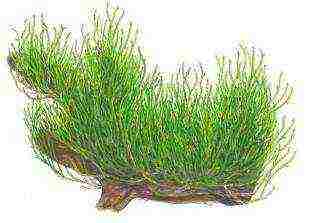Content [show]
Bloom. The flowering stage starts from the moment the flower arrow appears until the buds wither. The flowering period is three weeks on average. For two weeks, the flower arrow grows, for 1-2 days the buds bloom (all can bloom at once, they can take turns) and for about a week the flowers are kept in dissolution. The duration of the flowering period depends on the temperature conditions (the higher the temperature, the faster the peduncle grows, the buds bloom faster, the buds wither faster), the number of peduncles (when the bulb blooms with several peduncles, the flowering period can be up to 1.5 months), from varietal features (terry varieties fade 1-2 days earlier than non-terry varieties).
Flowering usually once a year (in autumn or winter, or early spring), and with good care, again in summer. The timing largely depends on the care (when the bulb was sent to rest) and also on the varietal characteristics (there are varieties that bloom at a certain time).
The growing season or growth period. During this period, the hippeastrum recovers after flowering, increases the leaves and volume of the bulb, lays flower stalks for future flowering. This period is very important, future flowering depends on it. Lasts on average about 8-9 months, and sometimes longer. The timing depends on the recovery of the bulb. Longer, heavily thinned bulbs and bulbs after illness (rot, red burn) are restored.
Rest period. It starts from the moment when the bulb is harvested in a dark, cool place, and lasts an average of 3 months. Duration depends on the previous season and storage conditions. Healthy, well-fed bulbs are sent to rest.
It is advisable to transplant once a year, hippeastrum are gluttonous and the supply of nutrients in the soil is consumed quickly. You can transplant either before retirement, or after a period of rest, i.e. before flowering. In some cases, for example, the purchased hippeastrum has faded, can be transplanted after flowering. It is undesirable to transplant during the flowering period.
Hippeastrum is planted so that a third of the bulb is raised above the ground.
In a healthy bulb, only those scales that can be easily removed can be removed. Brown scales that are close to the bulb and cannot be removed do not need to be removed.
The soil should be light in composition, with good water and air permeability, rich in organic matter. Weakly acidic pH - 5.6-6. You can use commercially available primer or mix it yourself.The choice of purchased soils is large, there are special soils for bulbous.
It is better to add sand or vermiculite to the purchased soil for greater looseness. If you want to make the soil yourself, then the composition is as follows: clay-soddy soil, leafy soil, humus, peat and sand (2: 1: 1: 1: 1)
For the summer you can. In the garden, they grow very well and stock up on strength for future flowering. Just do not forget about pests (there are more of them in the garden than in indoor conditions), rodents and that the weather is changeable. During frosts, heavy rains, the bulbs should be covered. You need to dig up the bulbs before the first autumn frosts.
The composition of the top dressing depends on the stage of development. The most important element is potassium. Fertilize about once every two weeks.
During flowering - emphasis on phosphorus-potassium and low nitrogen content.
At the beginning of the growing season, the emphasis is on nitrogen-potassium, in the middle of nitrogen-phosphorus in equal proportions, potassium is slightly more.
A month before the dormant period, feeding is stopped.
A few rules: it is impossible to fertilize on dry soil, after transplanting the first top dressing not earlier than after 1.5-2 months, carefully read the instructions and dilute according to the instructions, avoid overdoses.
Hippeastrum is good for both organics and minerals. Ideally, it's best to alternate between them. There are also special fertilizers for bulbous plants.
Flowering period. Until the arrow has grown by 10-15 cm, watering as it dries (i.e. the top layer should dry well between waterings). As soon as the peduncle begins to open, watering needs to be increased, but no swamp. Hippeastrum do not like the bay.
The growing season. Watering as the top layer dries.
Rest period. Watering once every 1.5 months is not very plentiful. Watering should be careful, in no case should water get on the bulb, otherwise the upper scales may rot.
Seeds, babies, dividing the bulb.
As a rule, it is used in breeding for the development of new varieties and hybrids. With seed propagation of the variety, 100% compliance with the parental form of the seedlings is not guaranteed. Self-pollination does not give a 100% guarantee that the same variety will turn out. There are species that cannot self-pollinate. This breeding method is the most laborious and time consuming. The bulb grown from seeds blooms with good care for the 5-6th year.
The pollination process is simple: the stigma of the pistil of a flower of one variety of hippeastrum is pollinated with the pollen of other varieties, pollinated several times from the moment of divergence of the blades of the stigma of the pistil to complete divergence.
Only healthy bulbs are selected for pollination.
It takes about 1.5-2 months to ripen the seeds. The seeds can be harvested when the seed pod begins to open. Not all seeds are suitable for planting, there are "dummies" (that is, there is no embryo inside), so the seeds are sorted out before planting. The largest, plump seeds are selected (the embryo is felt to the touch). The sorted seeds can be sown in the ground, lightly sprinkled with earth, or put in some water (with activated carbon) and wait for germination, as soon as the white root hatches, planted in the ground (with the white root down). The distance between the seeds when planting is 1.5-2 cm.
For seed germination and seedling growth, light, warmth and proper watering are important. The soil should be slightly moist, the temperature is 20-23 degrees. If these conditions are not met, the seeds may not sprout or rot. The germination rate of fresh seeds is almost 100%.
Seedlings should be planted as they grow. Don't forget to fertilize.
Spring seedlings are stronger than autumn ones, so seed reproduction is best done in spring. In addition, autumn seedlings should be supplemented in winter.
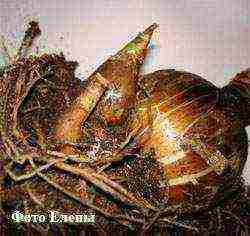
Reproduction of hippeastrum by children
This method allows you to preserve all varietal characteristics, but the multiplication factor is low. Children are formed irregularly. The education of children largely depends on the variety, for example, sibisters La Paz, Giraffe easily give children, but terry varieties are reluctant.
The babies are separated from the mother's bulb during transplantation.When separating, the baby should be at least 2 cm, with good roots. With good care, babies bloom in the 4th year.
Reproduction of the hippeastrum by dividing the bulb
This method is rarely used among amateur florists. First, because you need to cut a healthy onion. Secondly, there is a risk of losing the bulb and not getting children (there is a high probability of introducing infection into the wound). But the breeding rate is high and the resulting children retain their varietal characteristics.
Adult, healthy bulbs are selected for reproduction. Dried bulbs that have been stored for a long time, as well as bulbs during the flowering period and immediately after flowering, are not suitable for division.
Selected bulbs are washed in clean running water and cleaned of old outer scales. The roots and the bottom, if it is too high, are cut with a sterile knife (the bottom cannot be cut off completely). Remove 1 / 3-1 / 4 from the top of the onion. Then the onion is cut vertically into 8-16 parts (segments). The width of a segment is 1–2 cm. The number of segments depends on the size of the bulb; the larger the bulb, the more segments. Then each segment is cut into 3-5 divisions, consisting of two scales, fastened at the base with a piece of the bottom. Depending on the size of the uterine bulb, you can get 50-60 or more divisions from one bulb. Before planting, the plots are etched in a fungicide (in Maxim, in vitaros or in a foundation).
Delenki are planted in perlite, sawdust, river sand or in substrates prepared from these components with the addition of peat. The thickness of the substrate layer should be at least 10-12 cm. Heavy substrates in terms of texture are not suitable for planting divisions. Before planting, the substrate is steamed or spilled over the entire thickness of its layer with fungicides to destroy the harmful microflora in it.
The distance between the divisions during planting is small - 1200 - 1500 divisions per 1 m squared. They are planted in boxes or on racks with bottom heating. Landing is carried out to a depth of no more than 1/3 of the height of the cut. Deeper planting leads to decay of the divisions, a decrease in reproductive productivity, and retards the growth and development of the resulting daughter bulbs.
Planting can also be carried out in segments, without dividing them into divisions. But the productivity of reproduction, despite the large number of daughter bulbs formed by one segment, is lower, since the number of planting units obtained from one bulb is much less than when the bulb is divided into divisions. Planting in segments is used only when it is necessary to divide small bulbs with a small amount of scales.
The formation of daughter bulbs occurs a month after the planting of the divisions at the place of attachment of the scales to the bottom. Each delenka forms 1-2, and individual delenki up to 6, daughter bulbs. Three months after planting the delenok, the newly formed daughter bulbs have an independent root system and 2-3 leaves. At this age, the plants are transplanted. Reproduction success by the paired scale method depends on the temperature and humidity of the substrate.
The temperature of the substrate during the formation of daughter bulbs is maintained in the range of 22-24 ° C, air temperature - 1-2 ° C lower. A lower temperature, as well as its sharp drops during the formation of daughter bulbs, lead to a sharp decrease in breeding productivity.
The substrate must be constantly moist. Overmoistening and drying out of the substrate reduces the productivity of reproduction. Air humidity is maintained within 75-80%. Increased humidity and stagnation of air, a decrease and sharp changes in temperature contribute to the massive development of stagonosporosis.
Top dressing is carried out after the appearance of an independent root system and leaf apparatus in plants. Plants that are grown on substrates that do not contain nutrients (perlite, sawdust, river sand) are especially in need of feeding.Top dressing is carried out with liquid organic or mineral fertilizers twice a month.
Care during the formation of daughter bulbs and in the initial period of plant life consists in carrying out systematic watering, fertilizing, loosening the soil and protecting plants from diseases and pests.
Choosing an onion in a store
Question: How to choose the right onion in the store? What should you pay attention to?
During the season of forcing (autumn or spring), hippeastrum can be bought either in bulk (without soil in a plastic bag, on which the variety and supplier are written), or in a pot.
When buying, carefully inspect the bulb. The neck, bottom and the bulb itself should be strong, dense. The top flakes should be dry and brown in color. There should be no seals, darkening, redness, rot.
When buying a bulb in a pot, pay attention to the roots (they can be seen through the drainage hole (the roots should be white)), the bulb to the touch (should be strong), the upper scales should be dry brown (soft, wet - rot), on the leaves (if any) and the bulb should not be red.
When buying an onion at a discounted price, try to find out the reason for the discount. Prices are reduced for faded bulbs at the end of the planting season. Sometimes, filled with rotten bulbs are sold at discounted prices. And it is also worth noting that in stores very often there is a mix-up.
Questions about flowering hippeastrum

Question: How long does hippeastrum bloom?
On average, the flowering period takes 3 weeks (from the moment the peduncle appears to the withering of the buds). The flowering period is extended when the bulb blooms with several peduncles (after all, the peduncles do not always bloom at the same time, it happens one after the other).
The temperature also affects the flowering time. At a temperature of deg. 25 the peduncle grows quickly, the bud opens quickly, and the bud quickly fades. Optimum temperature deg. 18-20. There is a little trick: as soon as the bud opens, the hippeastrum can be transferred to a cooler place (degree 16), then the flowering will last longer.
Question: Hippeastrum grows leaves, does not want to bloom. How to achieve flowering?
First of all, you need to think about the conditions in which hippeastrum is contained.
1. The bulb may be too small. Usually bulbs less than 6 cm are children, or bulbs that have spent a lot of energy on flowering and are too weak after flowering. Such bulbs bloom early, you need to increase the volume, i.e. you need feeding (nitrogen-potassium) and light, you do not need to arrange a dormant period.
2. For flowering, it is very important that the bulb regains its strength during the growth period and sets a flower arrow (usually an arrow is laid after every 4th leaf).
3. The bulb lacks nutrients. Think about how long ago you transplanted your bulb. It is advisable to replant even an adult bulb every year, since during the growth period, the hippeastrum eats up all the nutrients in the soil. In addition to transplanting, the bulb needs proper feeding to restore strength. During flowering - phosphorus-potassium and little nitrogen content, after flowering nitrogen-potassium and little phosphorus content.
4. Lack of light. Think about your illumination. Hippeastrum are photophilous and can be safely placed on a sunny south window.
With such illumination during the growth period (spring-summer), they will get stronger and lay a flower arrow, or maybe more than one. A bulb that has received insufficient light, for example, has stood on the northern windowsill all spring and summer, or, in a place where the sun's rays rarely fall, may not bloom.
5. In what capacity the hippeastrum is planted. The pot should not be very spacious. The distance from the bulb to the wall of the pot is no more than 3 cm.
6. Do not forget about the rest period. After a vigorous growth period, the bulb needs to rest in a dark, cool place for two to three months.
Question: Bulb 3 cm, why doesn't it bloom?
This is a baby, she's too small to bloom.
Question: A third peduncle has appeared, I'm worried about the bulb.Will she have enough strength?
A well-fed bulb blooms calmly with three peduncles. If you are worried about the onion, then, as soon as the bud opens, the peduncle can be cut off and put into water.
Question: On the third arrow, the flowers were not as large as on the first two. Why?
I didn't have enough strength. Such a peduncle, as soon as the buds open, it is better to cut and put in water.
Question: How many flowers can there be on one peduncle?
From 2 to 6. The amount depends on the age of the bulb and on the varietal characteristics.
Question: Why does the hippeastrum have a peduncle more than 80 cm?
Or there is not enough light. The more light, the shorter the peduncle.
Question: A peduncle has appeared, the leaves of the bulb are 60 cm. Do I need to cut the leaves?
You do not need to trim the leaves. This is stress, you will need strength to heal the wound (cut site) and new leaves. Why waste her extra energy? All her strength is now going to flowering.
Question: Is it possible to get bloom by a certain date? I want it to bloom for the New Year.
Yes, you can. The calculation is as follows: on average, the rest period lasts 2.5 months (10 weeks), from the moment the flower arrow appears until the buds open, it takes about 3 weeks. In total, it turns out 13 weeks (a little over 3 months). So, in order to get bloom for the New Year, you need to send the bulb to rest in early October.
Question: Is it realistic to achieve flowering on the northern windows?
Hippeastrum are photophilous and feel more comfortable on the southern, western, eastern windows. You can make it bloom on the north window, northwest, northeast window. But the hippeastrum grows the bulb and recovers poorly after flowering, spends a lot of energy on flowering (the bulb is noticeably losing weight), the leaves are long and not so many, the peduncles are very long and elongated.
Question:The peduncle rotates around its axis. Is it okay?
It's okay, he's reaching for the light.
Question: The buds wilted. When do you need to remove a peduncle?
In order not to weaken the peduncle bulb after the buds have wilted, you need to cut it off.
Question: Is it true that it is very difficult to achieve the next flowering from the Dutch?
It is a myth. Flowering does not depend on the "Dutch", but on the conditions of detention.
The growing season of hippeastrum
Question: After flowering, a bulb with voids. Is this normal?
She spent her energy on flowering, and therefore voids were formed. There is nothing wrong, the bulb needs to be restored. Over time, the voids will close. Try to water more carefully so that the water does not get into the "voids".
Question: The bulb after abundant flowering (there were 3 peduncles) has lost a lot of weight. How can you help her recover? And will it recover to its original size?
Under indoor conditions, the bulb can recover to its original size, it all depends on the care. To recover, she needs: a sufficient amount of light, proper feeding, watering. Bulbs that have bloomed with three peduncles are the slowest to recover. Such bulbs have spent a lot of energy on flowering and can safely miss the next flowering.
Question: Hippeastrum bloomed with three arrows last year. Refuses to bloom this year. Care according to the rules (light, feeding, rest). The bulb is strong, during the growing season it has grown 10 leaves, retired by itself. Why didn't it bloom?
It is possible that hippeastrum missed flowering. I spent a lot of energy on the previous flowering. And during the growing season, he only managed to grow a bulb. Continue leaving, it will bloom next year.
Question: Hippeastrum has bloomed, the arrow has withered, and there are no leaves? Now he has what: vegetation or immediately rest?
Vegetation. There are varieties that bloom in a leafless state. Leaves appear within a month.
If a thriving bulb has recently been purchased, it is possible that it has no roots. She spent all her energy on flowering, now she is building up roots, then leaves will appear.
Question: Hippeastrum has faded. The first leaf appeared and almost immediately turned yellow, a little later two more leaves appeared, and they turned yellow and dried up.The bulb is strong, dense, no rot. Transplanted, there were no roots during transplantation. Watering is neat. Stands on the east window. What with her?
Most likely, the problem is the lack of roots. Healthy leaves will appear as soon as the bulb has roots. It is possible to stimulate the formation of roots with "root" or "heterosexin".
Question: The purchased hippeastrum has faded; when purchased, it is planted in peat. I want to transplant. Can you transplant after flowering?
It is possible and even necessary. When transplanting, it is imperative to inspect the roots, they are often poured in the store, and rot forms on the roots and bulb. Old peat must be removed from the roots, and etched in Maxim (or another fungicide) before planting.
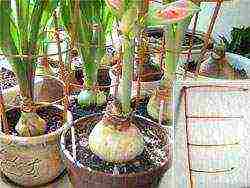
Question: At the hippeastrum, too long leaves are overwhelmed, what kind of support to come up with?
In the store, you can find various supports, like those shown in the photo. If you connect them together, or use them separately, you get a convenient support for the leaves. Supports can be plastic or bamboo. You can use a woolen thread to tie the leaves to the support.
Question: How to properly cut a peduncle after flowering?
Cut so that about 10 cm from the peduncle remains from the neck of the bulb. After the remainder of the peduncle dries up, it can be easily twisted. By the remainder of the peduncle, you can see whether the bulb is healthy or not. In a healthy bulb, the peduncle is dry, in a diseased bulb, the peduncle is slimy, soft, with redness.
Question: Leaves emerged from the ground, what are they?
These are the leaves from the baby.
Question: The leaves have a red tint. What is this red burn?
If the reddening is uniform, on all leaves and begins at the base of the leaves, then this is a varietal feature and suggests that the onion blooms in red or with a predominance of red and dark red. Cultivars whose foliage turns purple: Red Lion, Benfica, Lima, Papilio Butterfly, Rapido, La Paz.
If there are sudden red streaks on the leaves or red spots, then rot or "red burn" is the cause.
The rest period of the hippeastrum
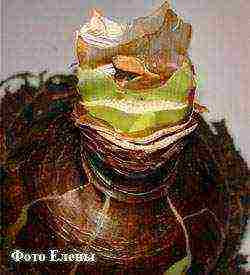
Question: At the hippeastrum, the leaves began to turn yellow and wither. Maybe he's going to retire?
Look at the onion. Have you grown up? grew leaves during the growing season? If so, the bulb is going to rest. Place in a cool, dark place and reduce watering. The bulb will take all the nutrients from the leaves.
Question: I bought hippeastrum in early November, it faded. For 4 months of growth, I grew 7 leaves. Do I need to send him to rest (now March)?
Early retirement, the bulb did not have time to recover. Ship in early fall.
Question: How to send an onion to rest?
Remove the onion in a dark, cool place. You do not need to cut the leaves, the bulb will take nutrients from them. After a while, the leaves will turn yellow and wilted and can be easily removed.
Question: Why send to rest?
I have, without a dormant period, hippeastrum blooms once a year.
And if you do not want to expel, you can not arrange a dormant period. In this case, it is difficult to predict flowering.
Question: How to determine if the hippeastrum bulb is awake?
The bulb woke up as soon as the peduncle or leaves appeared.
Question: When to "wake up" the onion? Or wait for herself to wake up?
Already more than 2 months at rest. If it is cool, then it is enough to bring it to a warmer, bright place and the effect of distillation will work. If you do nothing, she will wake up when she considers it necessary.
Question: Hippeastrum retired three months ago. Now there is no flower arrow, no leaves, the bulb has lost weight. What to do?
The bulb gave all its strength to the previous flowering and did not recover. Take out the bulb, transplant it into fresh soil, let it grow and restore strength. Such a bulb is unlikely to thrive.
Question: Hippeastrum was sent to rest (in a dark cool place). I did not have time to dry the leaves, as new ones appeared. What to do with him?
Option one, the bulb is rested and ready to bloom.You can hold it for a little (a week or two) in a dark place (wait for the peduncle) or immediately put it on the windowsill.
Option two, early retirement. The bulb has not had time to recuperate and continues to grow. Reach out, let the bulb recover.
Question: Do I need to send the baby of the hippeastrum to rest?
No. Children do not need to arrange a rest period.
The difference between hippeastrum and amaryllis
Both plants belong to the same Amaryllidaceae family.
At first, both hippeastrum and amaryllis belonged to the genus Amaryllis. Subsequently, systematics, due to significant differences in the structure of plants, resulted in two different genera. The botanical name amaryllis went to the species amaryllis belladonna, the rest got the name hippeastrum.
| Number of species | Approximately 50-70 species, although some sources mention up to 85 species | one species Amaryllis Belladonna |
| Origin | subtropics and tropics of America | South Africa |
| Number of chromosomes | X = 11. In most cases, it is incompatible with other genera of the Amaryllis family. | X = 11. Freely interbreeds with other genera of the Amaryllis family, including Krinum, Nerine, Brunswigia. |
| Evergreen or deciduous | Depends on the species, most species are deciduous, with a pronounced dormant period, but there are species without a pronounced dormant period (evergreen), for example, Hippeastrum Papilio. | With a pronounced dormant period, the leaves are shed during the dormant period. A dormant period is required for the development of a flower bud. |
| Flowering period | Usually blooms once a year. The flowering period depends on the forcing: early forcing - autumn flowering, late - flowering in winter and spring. Some hippeastrum flowers bloom twice a year, re-blooming usually in summer. | The end of summer, autumn. Flowering once a year. |
| Peduncle (main difference) | Hollow, cylindrical, up to 90 cm high, the color of the peduncle is usually green, but it can be green with crimson, with gray or brown shades | Not hollow, up to 96 cm high, with a purple tint. |
| Number of flowers per peduncle | Usually from 2 to 6, but some species have up to 15 flowers with little or no odor. The number of flowers depends on the species and variety, for example, in the species wild-growing Hippeastrum fosteri, up to 15 flowers develop on one peduncle, in the small-flowered Rapido up to 9, in the small-flowered Jaguar up to 8, in the double-flowered medium-flowered Alfresco up to 8. | from 6 to 12 fragrant flowers. |
| Color of flowers | Red, pink, orange, yellow, green, cream, white; one-color or two-color; striped, streaked, speckled. | Shades of pink from deep pink-red to almost white. |
| Flower shape | Varied: double, long-tubular, orchid-like, similar in shape to Leopoldii and Reginae, etc. | funnel-shaped |
| Flower size | Depends on the variety and type: from 5 cm to 22 cm | from 9 to 13 cm |
| Perianth petals | 6 similar or different in shape and size (depending on the type) | 6 similar in shape and size |
| Bracts (inflorescence protective casing) | 2 | 2 |
| Perianth tube | Depending on the species, it can be very long up to 15 cm or very short 2-4 cm. | short |
| Leaves | Depending on the species, the leaves are green, glossy or dull, silky or hard, long, belt-like. Appear before or at the same time as the flower arrow. The length of the leaves is up to 90 cm, the width is 3.5-5 cm. | The leaves are narrow, bright green, glossy. The shape is grooved. Leaf length up to 60 cm, width up to 3.5 cm. Appear after flowering (i.e. bloom in a leafless state). |
| Bulb, shape | symmetrical. Depending on the type, the shape can be different, round, round-conical or slightly elongated. | pear-shaped |
| Bulb, diameter (mature, flowering) | 7 cm - more than 10 cm.The size depends on the variety: most wild species, tubular and small-flowered varieties have small bulbs, large-flowered and terry varieties have large bulbs in an adult plant capable of flowering. The size of the bulb depends on the cultivar (the small-flowered bulb is smaller than the large-flowered bulb) |
more than 12 cm. |
| Scales | white, resemble onion scales in structure, the scales break easily (effortlessly) | grayish in color, have pubescence on the inside (the pubescence looks like cotton wool or cobweb), it is difficult to break the scales |
| Seeds | In the seed capsule there are about 30-45 flat, fly-winged, black, disc-shaped seeds. The embryo is covered with a black protective cloth. | The seed capsule contains about 20 thick, bulbous, light pomegranate seeds. |
| Germination of seeds (germination) | Usually about 2 weeks, sometimes a little more. | About 56 days. |
| Feature of the education of children | Usually, babies appear closer to the drying out scales. | An interesting feature in adult bulbs, babies appear between the scales in the middle of the bulb, and several points of growth are obtained. |
| Growing features | Grows well and blooms well indoors. Typically, the growing season is in the spring - summer, the dormant period - in autumn, early winter, flowering period - late autumn, winter, spring. | In indoor conditions, it grows and blooms difficult, since its biological cycle is disrupted. The plant is native to Africa and blooms when it is spring in Africa, during the rainy season. After flowering, it grows, and during drought and high temperatures, it rests. In our conditions, the African spring falls in autumn, so it blooms here (in Russia) in the fall. During the period of growth (in our conditions, winter-spring), he does not have enough light. The plant is very light-requiring. Best grown in a garden in direct sunlight. The temperature should not be lower than 10 degrees, so in the fall they need to be dug up and removed more in a warm, lighted place. |

It is believed that these flowers, planted in the garden, do not bloom. Is it really?
I still have a small collection of hippeastrum, but the plants are one of my favorites. Every summer I plant them in open ground. At the end of May, I prepared the beds, filling the soil with compost soil and peat (1 bucket per 1 sq. M). When planting, I put 1 tbsp under each onion. fertilizers "Malysho" (for peppers and tomatoes) and wood ash. Wells spilled with a solution of potassium permanganate.
To make the plants suffer less from the rains, I made a shelter by placing high arcs, on which I threw a dense acrylic material. In rainy weather, she covered it with a film from above.
Two weeks after disembarkation start feed hippeastrum with various flower fertilizers - alternated Kemira, Agrolix, Ideal, Agricola, Kaleidoscope (for bulbous) and even Sudarushka (for tomatoes). In addition, I sprayed the leaves with Ideal - this gives them a shiny and healthy look. In addition, she used an infusion of weeds, manure and ash. I fed every week with one of the drugs or organic matter.
On hot days, I took off the shelter, and the bulbs “roasted” their sides in the open sun - it is believed that this is a good prevention of a red burn. And yet a few bulbs got sick... I tried many ways to deal with a red burn. And the most effective was the gruel of chalk and copper sulfate (it can be replaced with foundation). It must be thick so that after coating with this composition, a shell forms on the bulbs. And when it falls off along with the upper scales, a healthy green scale appears.
Your hippeastrum planting in the most inconspicuous corner of the garden, but always well lit by the sun. I do this only so that they grow up, improve their health and gain strength, because it is believed that plants do not bloom in open ground. So I thought until recently. But in early July, one of the planted hippeastrum gave a peduncle, and a few days later four more plants were going to bloom. Moreover, one of them had a "debut", which turned out to be quite successful - two peduncles at once.
In indoor conditions, the flowers on my hippeastrum lasted no more than a week, in the garden they bloomed three times longer! Isn't it a miracle!
Blooming hippeastrum fascinates with its beauty. Only once a year, he pleases us with huge flowers-stars. And what is the disappointment when the long-awaited flower does not appear, or the plant begins to wither altogether.To avoid such troubles and be able to enjoy the contemplation of this wonderful flower, you need to know some secrets of care and adhere to them. A grateful plant will surely delight the eye with generous flowering.
Description of hippeastrum
Appearance
Hippeastrum (Latin Hippeastrum) is a perennial bulbous plant. Leaves are linear, shiny leaves, 50–70 cm long, 4–5 cm wide, have shallow grooves on the surface. The leaves are arranged in two rows. During the flowering period, the plant produces a powerful, high (up to 60–80 cm) peduncle.
The name of the flower is translated from ancient Greek as "star rider".
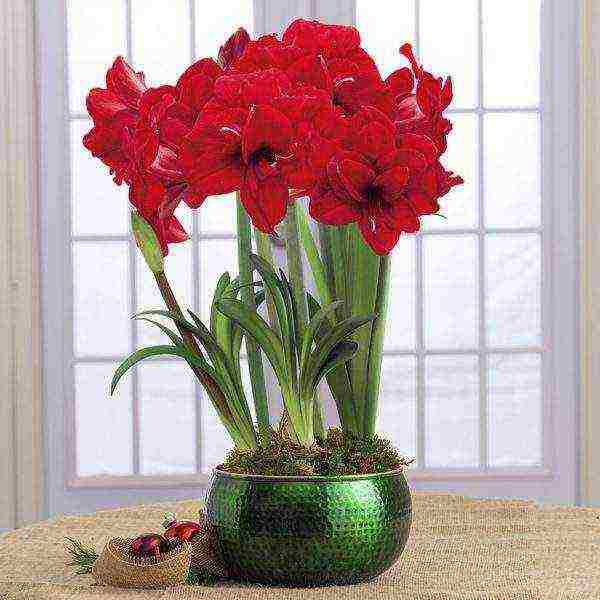
Hippeastrum during flowering - a subject of pride and admiration
The flowers are funnel-shaped. Their color range is quite wide: reds, whites, oranges, pinks, purples, sometimes yellow or greenish shades. The main tone can be complemented by strokes or specks.
The flowers are large - up to 20 cm in diameter, collected in an umbrella inflorescence. Hippeastrum has a very faint odor. Some species don't smell at all. This is a great benefit for people prone to allergic reactions.
Flowering hippeastrum - video
Natural habitat and home maintenance
The homeland of the hippeastrum is the American tropics and subtropics, in particular the Amazon basin. It was introduced to Europe in the 16th century and quickly gained admirers all over the world. In 1799, Johnson's first hybrid hippeastrum was introduced. Today these flowers are widely used as a houseplant and are also grown for cutting. Hippeastrum is not very difficult to care for. Even novice growers can easily cope with this task.
Variety of varieties of hippeastrum
This plant belongs to the Amaryllis family and has about 90 species and more than 2 thousand varieties.
In indoor floriculture, hybrid hippeastrum (hippeastrum hybrida) is most often cultivated. The classification of varietal hippeastrum is based on two characteristics: the size and shape of the flower. Depending on this, plants are conventionally divided into 9 groups, which are indicated in the table.
The most popular groups and varieties of hippeastrum - table
Magnificent hippeastrum in the photo
Similarities and differences with amaryllis

Amaryllis is often referred to as hippeastrum varieties, but this is mistaken
Hippeastrum is often confused with amaryllis or the names of these flowers are considered synonymous. Even on sale hippeastrum can go under the name "amaryllis" or vice versa. They are indeed relatives belonging to the same botanical family - amaryllidaceae, but representing different genera.
Outwardly, these plants are very similar and require almost the same care. Biologically, they are arranged in different ways. The main differences are presented in the table.
Biological differences between hippeastrum and amaryllis - table
Optimal conditions for growing a flower
The practice of cultivating this plant shows that the beauty of the hippeastrum depends on the optimal parameters of temperature, humidity and illumination. Intense bloom provides a full dormant period in a dark, dry and cool place for at least 8-10 weeks. "Tired" hippeastrum most often gives small flowers on a short peduncle or does not bloom at all.
At the moment the bulb wakes up, the conditions should be gradually (but not drastically) changed: transfer the plant to a warm, but not too brightly lit room and increase watering to moderate. Thus, the formation and development of peduncles is stimulated. In cold climates, this process is greatly slowed down.
If a plant hits bright light from the dark, in combination with excess moisture, it stimulates the rapid growth of the green mass, but noticeably inhibits the development of the peduncle.
In order for the hippeastrum to develop fully, it is necessary to observe the growing conditions given in the table.
Growing conditions for hippeastrum at different periods of development - table
Planting and transplanting
The planting time of the hippeastrum bulbs can be selected depending on the desired flowering period. This can be done regardless of the season. The plant will delight you with flowers about 5-9 weeks from the moment the shoots appear. Hippeastrum bulbs sold through the distribution network are ready to bloom. They have gone through a dormant period and do not need darkness.
Planting requires a deep (up to 15 cm) and narrow (no more than 5–6 cm larger than the bulb diameter) pot, preferably ceramic, always stable on a horizontal surface. A narrow pot is necessary to prevent excessive moisture and root rot. As an optimal substrate, you should use drainage, which fills the lower part of the pot, and a soil mixture consisting of equal parts of sand, turf, humus or peat.
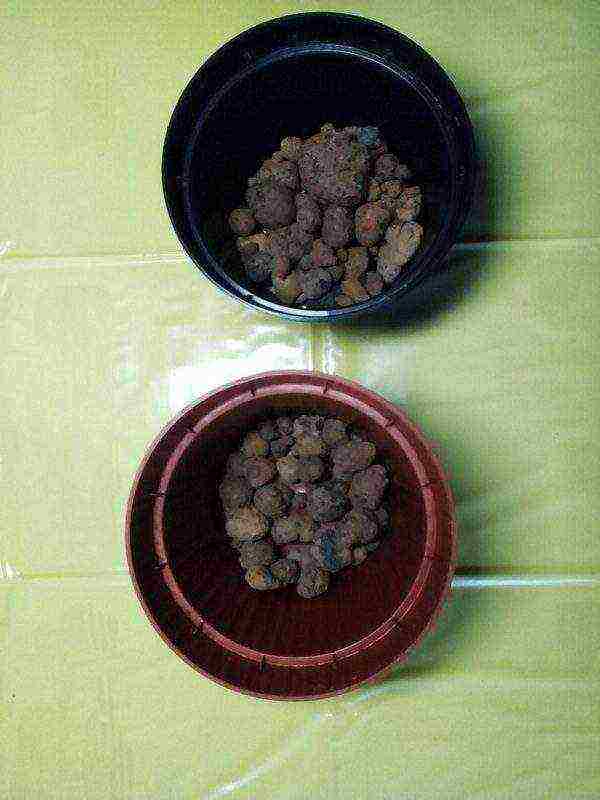
Drainage is a prerequisite for preventing excessive soil moisture and rotting of the bulb and roots
The bulb is planted in a slightly moist soil mixture, deepening it to a maximum of 2/3 of the height.
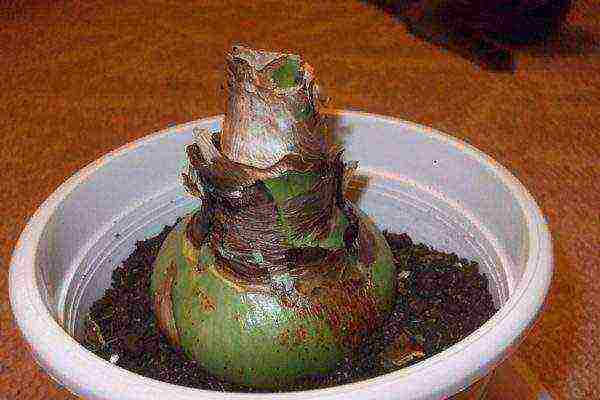
Narrow pot and shallow planting create optimal conditions for the hippeastrum
After planting, the plant only needs warmth. It is not necessary to water the hippeastrum before the sprouts appear.
If any damage is noticed on the bulb, it must first be healed. This procedure includes trimming rotten parts, keeping for 30 minutes in a fungicide solution (Fundazol, Maxima) or ordinary greenery and drying for a day.
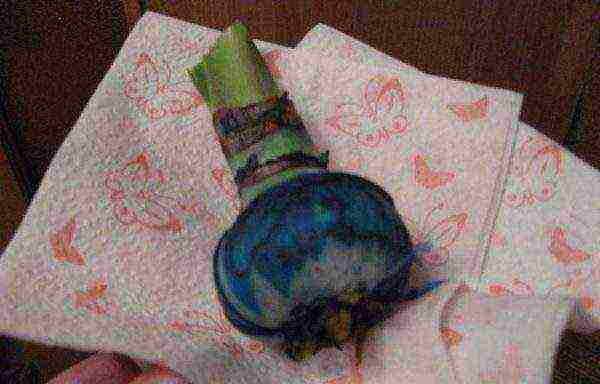
Processed hippeastrum bulb
It is necessary to plant such a bulb in the ground, where humus is replaced with a small amount of sphagnum (peat moss).
It is advisable to deepen the reanimated bulb into the soil by no more than 1/4 of its height. With such a planting, it is easier to control its condition and, if necessary, carry out spraying. After the bulbs have recovered, the soil mixture can be easily refilled to the usual level.
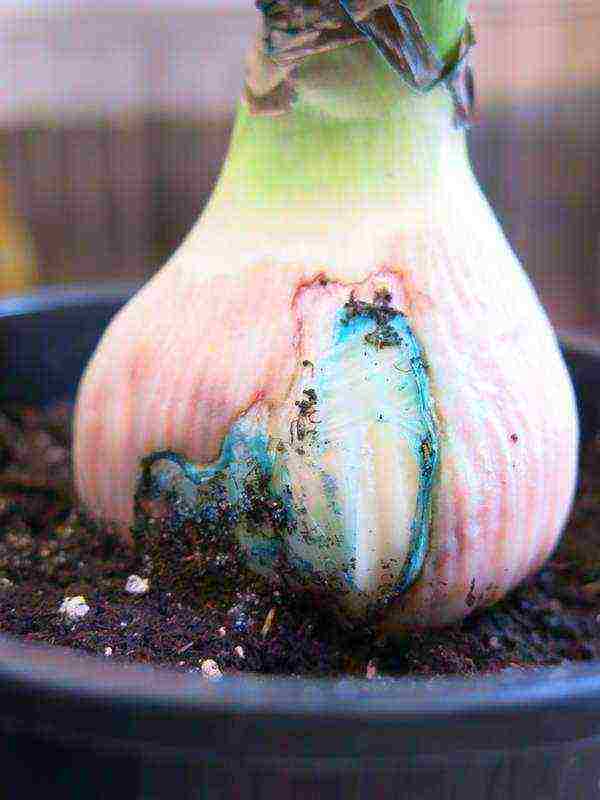
Surface planting of a damaged bulb
Having planted the plant in moist soil, it is placed in a warm, slightly shaded place (you can cover it with an empty pot) and watering is excluded until the peduncle is distilled to a height of 10 cm.
The optimal frequency of hippeastrum transplant is once every 3-4 years. A favorable time is the eve of the dormant period or its end. It is advisable to use the transshipment method when transplanting - to move the plant along with the earthen clod. In this case, the root system is minimally damaged, which contributes to the rapid rooting of the bulb and its active development.

Transfer method - a method of transplanting with minimal damage to the root system
Basic rules for caring for hippeastrum
Watering and feeding
As discussed above, the intensity of watering the hippeastrum is directly related to its life cycle. However, it is important to provide the plant with not only the required amount of moisture, but also correctly deliver it to the root system.
For example, it is not recommended to pour water on the bulb - it can rot. Better to combine top watering with pan watering. Thus, moisture will be evenly distributed over the earthen coma, which will exclude root rot. The main rule of watering hippeastrum: it is better to underfill than overflow. You also need to regularly wipe the leaves from dust or wash them with warm water.
During the growth of the peduncle, when it reaches a height of 12-15 cm, it is useful to water the soil with a weak solution of potassium permanganate. After 5-6 days after that, you need to feed the plant with phosphorus fertilizer.
Top dressing of hippeastrum is carried out regularly, at the beginning of the growing season - once every two weeks with liquid nitrogen-phosphorus-potassium (7: 3: 6) fertilizer (for deciduous plants). After the appearance of leaves, to stimulate the active formation of buds, hippeastrum requires less nitrogen and much more potassium, so the ratio of mineral components changes to the proportions of 4: 6: 12 (for flowering plants). The frequency of feeding is maintained.
A month before the onset of the dormant period, the hippeastrum needs fertilizers with an insignificant part of nitrogen and phosphorus and a large amount of potassium (4: 4: 12).
Carefully read the method of applying fertilizers on the packaging and do not exceed the indicated concentration of minerals. Otherwise, the root system of the plant can be burned.
Timely balanced feeding promotes high-quality flowering and deciduous growth. The base of the leaves forms the scales of the bulb and it grows in size. With insufficient nutrition or a complete lack of feeding, the bulb will use the nutrients accumulated from the leaves, but they are not enough to ensure flowering.
Some secrets of flowering
Sometimes hippeastrum disappoints flower growers by refusing to bloom. Why? There may be several reasons:
- Most often, the plant does not throw out a peduncle due to the depletion of the bulb. Hippeastrum requires a substantial amount of nutrients for flowering. Unsurprisingly, the potted soil is rapidly depleted. To avoid such problems, it is necessary to feed regularly and in sufficient quantities.
- A plant affected by pests (spider mites, worms or scale insects) tries to fight them and does not have the strength to bloom.
- Hippeastrum does not bloom even with rotting of the bulb, which occurs due to waterlogging of the soil.
To admire the blooming hippeastrum from year to year, one should not allow such situations. It is also useful to know some tricks of experienced florists to ensure 100% flowering of this plant:
- treating the bulb with hot (43–45 ºC) water for three hours before planting will cause the plant to bloom in three weeks;
- if you stop watering from August, move the plant to a dark, dry place and keep it there until the end of January, after which you resume watering, the flowers will delight you in 1.5 months;
- if you cut off all the leaves in July and do not water the hippeastrum for a month, and with the first watering introduce liquid complex fertilizing, the flowers will bloom in August or September.
In order to avoid scalding the roots, fertilizer should be applied only after preliminary moistening of the soil.
Immediately after flowering, it is necessary to cut off the wilted peduncle, continuing watering and feeding. And prepare the plant for good rest (dormant period). The next flowering directly depends on this.
Dormant period
The natural resting period of the hippeastrum lasts quite a long time: from September to January. If your plant grew outdoors in summer, by the beginning of autumn it must be brought into the house and gradually reduce watering until the leaves completely stop and dry out. You can trim the yellowed leaves yourself, from which the bulb has already taken nutrients.
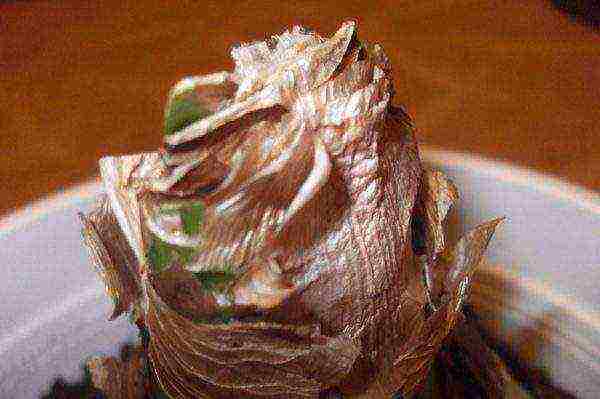
The quality of the next flowering depends on the dormant period.
After that, you should put (or put the pot with the plant on its side) in a dark and cool (5-12 ° C) room. Many growers keep them at a higher temperature - about 17-18 ° C. The soil should be slightly moistened once every 2-3 weeks to prevent drying out of the roots. It is not recommended to moisten and spray the onion.
The dormant period should last 1.5–3 months, depending on the planned time of the subsequent flowering of the plant. During this time, the hippeastrum does not "show signs of life." The development of leaves and peduncles occurs only inside the bulb.
After a period of rest, it is time for the hippeastrum to wake up. Leaves and peduncles appear on the surface of the bulb.
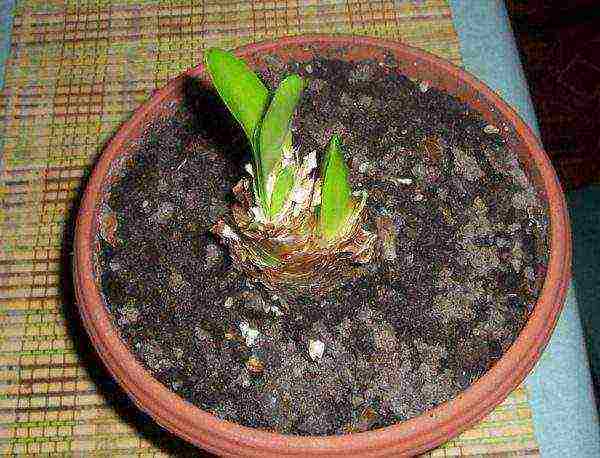
Simultaneous appearance of leaves and peduncle
Problems waking up after wintering
If the bulb does not wake up, you can, of course, be patient and wait for it to wake up on its own. But, as a rule, full-fledged flowering from the "belated" bulb will not work.
In this case, it is worth remembering in what state the plant “retired”. After all, the peduncle is laid in the bosom of every fourth leaf.If last year the green mass was not sufficiently grown, the bulb will be weakened.
And if there were less than four leaves, then in the new season the hippeastrum will probably refuse to bloom. Dry content can hardly be helped here. It is necessary to provide a very warm temperature, actively water and feed.
Care errors and their correction
It is not very difficult to care for hippeastrum, but it is imperative to follow the rules of watering, feeding and lighting at different periods of the plant's life cycle.
Common mistakes in caring for hippeastrum - table
Diseases and pests of the hippeastrum
Hippeastrum is not too susceptible to disease. It is most often affected by a red burn (red burn fungus or stagonosporosis), red rot and downy mildew. Some pests can also bother this plant: spider mites, scale insects, aphids, worms. You can determine what a plant is sick with by its appearance.
The main diseases and pests of the hippeastrum and how to combat them - table
The most common diseases and pests of the hippeastrum in the photo
Reproduction
Hippeastrum reproduces in two ways: seed and vegetative.
Seed method
The seed method is rather complicated and time-consuming. Seeds are formed only 1.5–2 months after flowering. But they do not form on their own. It is necessary to artificially pollinate pistils and stamens. The grown ovary looks like a large tricuspid capsule.

Ripening of hippeastrum seeds
Inside the capsule, there are rows of flattened seeds of an irregular rounded shape. They are characterized by a black color with a brown tint and the presence of thin black wings.
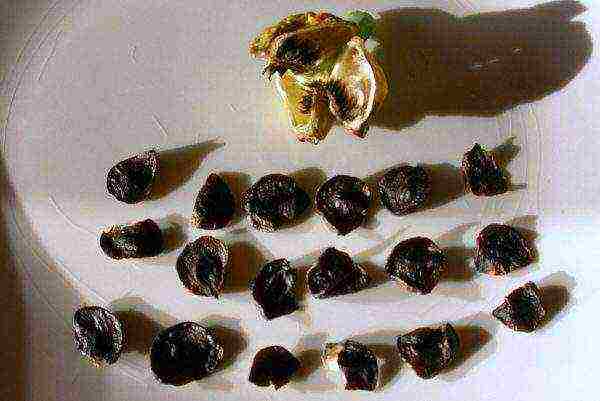
Seeds ready for sowing
In spring they are planted in sandy-leafy soil. It is important to take into account that freshly harvested seeds have one hundred percent germination. From dried seeds, as a rule, only 30% of the total germinate. Seedlings will delight you in 15–5 days.

Sprouted hippeastrum seeds
When the leaves grow to 6–10 cm, they are transplanted into pots with a diameter of 6–7 cm. At this time, the bulb grows.
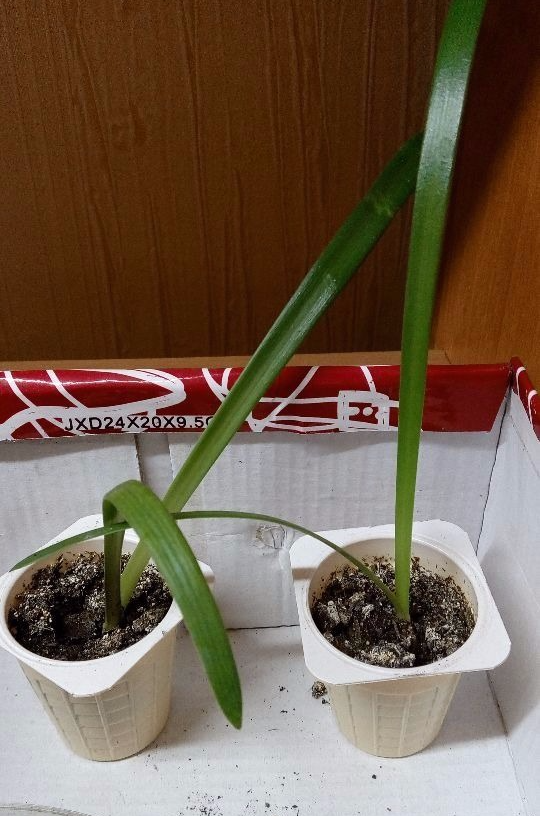
Grown seedlings of hippeastrum
The period until the first flowering of young plants of different varieties ranges from two to five years. This method is more acceptable to breeders. Most amateur flower growers consider it costly and ineffective. At the same time, there is no guarantee of the preservation of the maternal characteristics of the plant.
Vegetative method
It is much easier to propagate hippeastrum in a vegetative way. Several variants of it are practiced.
Propagation by daughter bulbs
This is a natural, and therefore the most optimal and simplest way. Bulbs of three years of age, with proper care, usually give 3 babies.
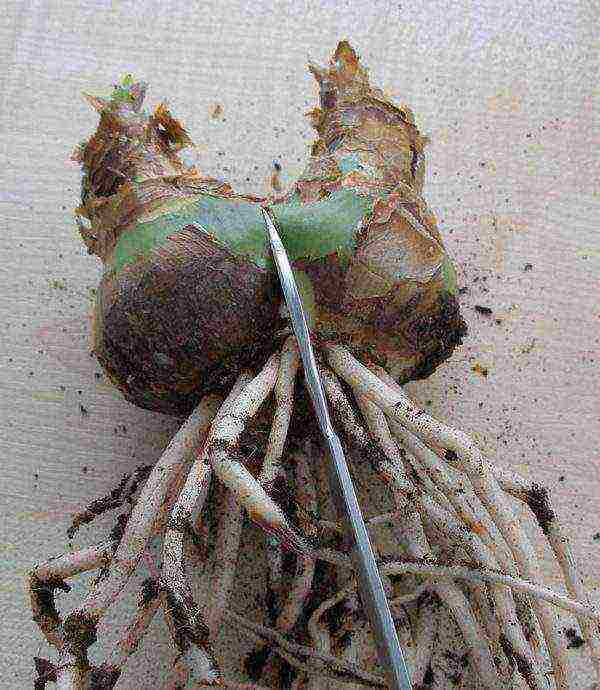
Separating the bulbs
They are separated with a sterile sharp instrument, treating the cuts with crushed coal. Planted in accordance with the rules for planting an adult bulb.
For two years, the newly planted plant is not deprived of its foliage and is not set to rest. The growth of the bulb and the formation of the peduncle in it depends on the intensity of the growth of the leaves. With good care, babies will throw out flower stalks in 2-3 years.
Dividing the bulb
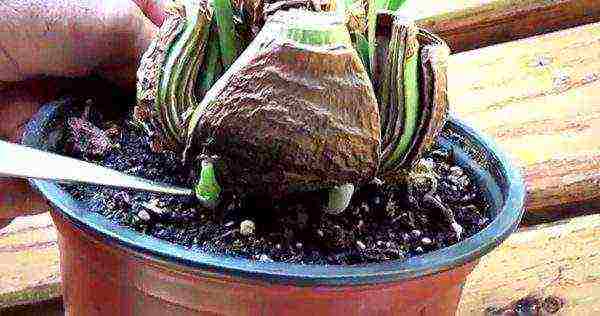
Split onion
The division is carried out during the maximum accumulation of nutrients in the bulb - in November.
Division process algorithm:
- Remove the top layer of the soil, leaving only the lower part of the bulb in the soil.
- Remove dry outer scales.
- Cut off the leaves along with the top of the bulb.
- Cut the onion into four equal parts to the surface of the soil.
- Insert knitting needles with a diameter of 5–6 cm into the incisions to prevent the parts of the bulb from closing.
- Adhere to all the rules of caring for an adult plant.
- With the appearance of leaves, feed and continue fertilizing according to the standard scheme.
- Divide the onion the following spring and place the parts in separate flowerpots.
You can divide the onion in another way: cut it, leaving a piece of the bottom and scales in each part. It is useful to sprinkle the sections with charcoal or activated carbon.Plant the resulting slices in a light peat mixture.
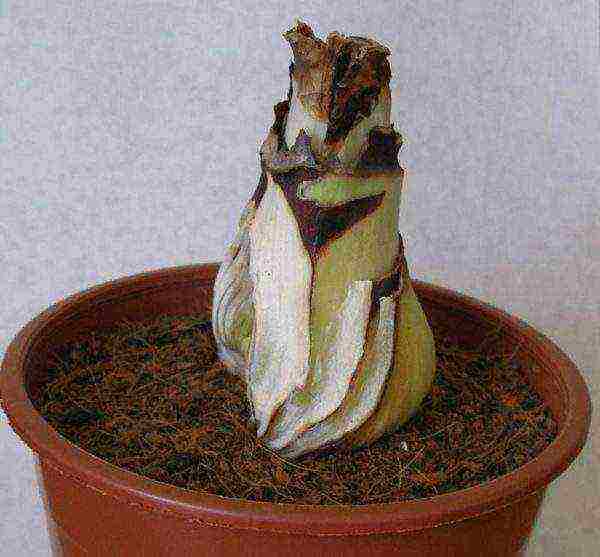
shallow planting in a light substrate
After 40-50 days, babies appear, which must be planted in pots in the spring.
Attention! When seating, one should not forget about the presence of toxic substances in the bulbs of the hippeastrum and adhere to safety rules.
Gardeners reviews
Pluses: easy to clean.
Disadvantages: This is my favorite flower, so there are no disadvantages at all.
I have two adult hippeastrum. Let's start with a dormant period. They have it under the kitchen sink, and I hardly water them. Just a little once a month. When the dormant period ends, I take out the flowers on the window and do not water until an arrow with a bud appears. Now you can water and gradually increase watering. If you start watering right away, without waiting for the arrow, then you risk not getting bloom. Strong foliage will just begin to grow, and the bud will not appear.
They multiply by bulbs very slowly. Therefore, I came up with the idea to pollinate them artificially and get seeds for sowing. Pollinated during flowering, they both bloomed at the same time. I just took a cotton swab and transferred the pollen from one flower to the pistil of another. Usually, after flowering, the flower dries up and falls off. At the same time, a green box was formed, in which there were seeds. When the box dried up and began to crack, I collected the seeds and sowed them in the ground to a depth of 1 centimeter in the fall. The first shoots appeared at the end of winter. What a joy it was))) There are 34 of them in the flowerpot, they are preparing for transplantation. These babies will bloom in about 2.5-3 years. It's only a shame that the hippeastrum grown in this way does not preserve the species characteristics of the parent plant. That is, my mother plant is red, but these small hippeastrum will bloom with completely different flowers, which will differ in both shade and shape. But this is even more interesting.
Kseny687654
Advantages: gorgeous flowering, unpretentiousness.
Disadvantages: blooms for only a few days.
I want to share with everyone a piece of my joy. I have two hippeastrum blossoms at once, it's right for my birthday! A wonderful gift! In general, hippeastrum are bulbous plants with juicy, long, green leaves, with huge flowers (there are up to 6 of them on one peduncle), each of the flowers is up to 25 cm in diameter! I have a little smaller, but nevertheless also large, especially on white. They bloom depending on the variety at different times. Flowers must have a dormant period for this. For example, mine have just faded, now they have released their leaves, they are in the process of growing. I water them (moderately), feed them, and they stand in the light. They will have a dormant period from October to February. By this time, their watering should be reduced. I put them in a dark place and gradually stop watering. Maximum once a month, and sometimes even less. The leaves that were on the flowers dry out and are easily removed. We take out the plant when the first leaves begin to hatch, put it on the windowsill and start watering. By the way, after flowering, we cut the peduncle so that its height is 15 cm, and then, when it dries, we separate it from the plant by hand. Propagated by bulbs and seeds. In the first case, flowering occurs in 3-4 years, and in the second - in 8 years. The plant is unpretentious and is not susceptible to almost any disease.
Lisichkina
Hippeastrum care is available even for very busy people. It requires a minimum of effort and provides maximum aesthetic pleasure. You will fall in love with this "star rider" at the first bloom. Grow and welcome spring with wonderful flowers in February!
By specialty - commodity expert of non-food products. I work as a teacher of commercial and commodity disciplines. Rate the article:
(15 votes, average: 4.4 out of 5)


